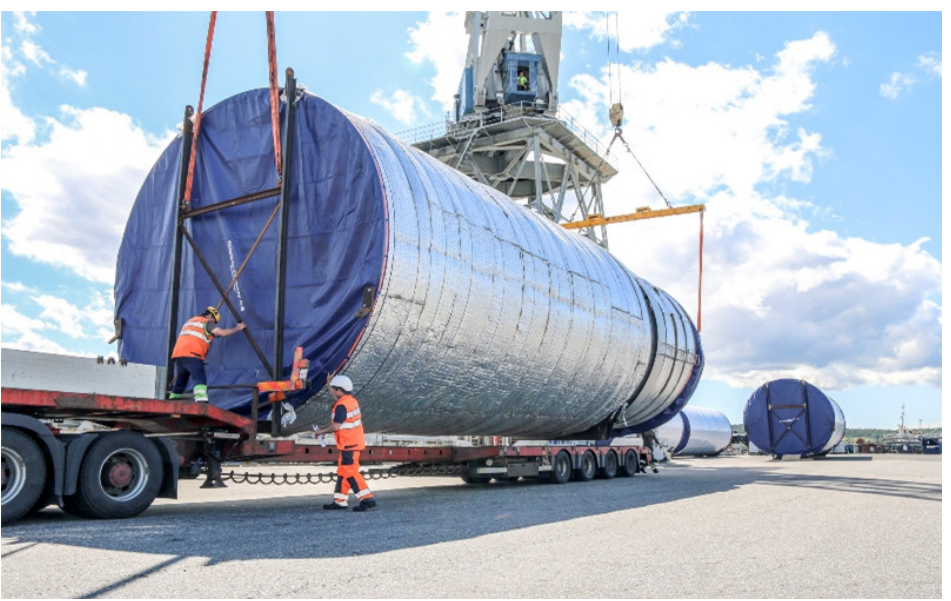Heavy-Lifts cargo Logistics
In the transportation of international engineering projects, the heavy-lift cargo's transportation is the most difficult. Standard Specifications for heavy-lift cargo:
(1) Dimensions of goods: with a length of more than 14 meters or a width of more than 3.5 meters or a height of more than 3 meters;
(2)weight more than 20 tons for single cargo or group (bundled) cargo that cannot be disintegrated.
Due to oversize and overweight, the transportation of heavy-lift cargo is limited by many conditions, such as the choice of inland transportation routes and the routes' conditions (including the width and height of road tunnels, bridge loads, local road regulations, etc.), the load-bearing level of transport vehicles, lifting capacity, ship binding, etc.
Heavy-lift cargo transportation has the following characteristics and requirements:
(1) Selection of domestic logistics routes. Know the alignment of road and the passage capacity of bridges and tunnel inadvance, including the transport restrictions of bridge and tunnel, the obstacles around the road, and then formulate the most appropriate transport organization plan. In addition,if relevant traffic regulations are involved, need declare in advance and obtain consent from the transportation authorities before starting the transportation.
(2)Ship Selection and cargo loading. As the heavy-lift cargo is customized according to the needs of projects, the size, weight, lifting point and transportation requirements of each cargoes are different.So we need to make separate transport plans and schemes for each cargo, and select ships according to the project schedule requirement.
(3) The high professional level of operators is demanded. Heavy-lift cargo transportation requires professional and experienced operators who can operate special vehicles, cranes, flexibly to deal with emergencies.
(4) Transportation risk is high. because of the oversized and overweight, slight carelessness or damaged in the transportation will cause extremely serious direct and indirect economic losses, which will affect the implementation of the project seriously.
In the transportation service of heavy-lift cargo, our company has a professional team, can provide customers with the best programs and services, including the routing design and the choice of vehicles and ships, the binding of goods and safety monitoring.

Appendix: Large objects are divided into four grades according to their shape, size and weight (including packaging and support):
(1) First-class large objects are those that meet one of the following criteria:
1/Length greater than 14 meters (including 14 meters) less than 20 meters;
2/ Width greater than 3.5 meters (including 3.5 meters) less than 4.5 meters;
3/Height greater than 3 meters (including 3 meters) less than 3.8 meters;
4/ Weight greater than 20 tons (including 20 tons) less than 100 tons.
(2) A large second-class object means one of the following standards:
1/Length greater than 20 meters (including 20 meters) less than 30 meters;
2/Width greater than 4.5 meters (including 4.5 meters) less than 5.5 meters;
3/Height greater than 3.8 meters (including 3.8 meters) less than 4.4 meters;
4/Weight greater than 100 tons (including 100 tons) less than 200 tons.
(3) Three-level large-scale objects refer to those that meet one of the following criteria:
1/Length greater than 30 meters (including 30 meters) less than 40 meters;
2/Width greater than 5.5 meters (including 5.5 meters) less than 6 meters;
3/Height greater than 4.4 meters (including 4.4 meters) less than 5 meters;
4/Weight greater than 200 tons (including 200 tons) less than 300 tons.
(4) Class 4 large objects are those that meet one of the following criteria:
1/Length of 40 meters or more;
2/Width of 6 meters or more;
3/The height is above 5 meters.
4/The weight is 300 tons or more.
Note: The level of large objects is determined by the highest level among the four conditions of length, width, height and weight.

